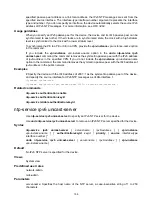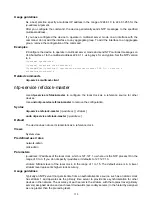
116
ntp-service unicast-peer
Use
ntp-service
unicast-peer
to specify a symmetric-passive peer for the device.
Use
undo ntp-service
unicast-peer
to remove the symmetric-passive peer specified for the device.
Syntax
ntp-service
unicast-peer
{
peer-name
|
ip-address
} [
vpn-instance
vpn-instance-name
]
[
authentication-keyid
keyid
|
priority
|
source
interface-type interface-number
|
version
number
]
*
undo
ntp-service
unicast-peer
{
peer-name
|
ip-address
} [
vpn-instance
vpn-instance-name
]
Default
No symmetric-passive peer is specified for the device.
Views
System view
Predefined user roles
network-admin
mdc-admin
Parameters
peer-name
: Specifies the host name of the symmetric-passive peer, a case-insensitive string of 1 to
253 characters.
ip-address
: Specifies the IP address of the symmetric-passive peer. It must be a unicast address,
rather than a broadcast address, a multicast address, or the IP address of the local clock.
vpn-instance
vpn-instance-name
: Specifies the MPLS L3VPN to which the symmetric-passive peer
belongs, where
vpn-instance-name
is a case-sensitive string of 1 to 31 characters. If the
symmetric-passive peer is on the public network, do not specify this option.
authentication-keyid
keyid
: Specifies the key ID to be used for sending NTP messages to the peer,
where
keyid
is in the range of 1 to 4294967295. If this option is not specified, the local device and the
peer do not authenticate each other.
priority
: Specifies the peer specified by
ip-address
or
peer-name
as the first choice under the same
condition.
source
interface-type interface-number
: Specifies the source interface for NTP messages. In an
NTP message the local device sends to its peer, the source IP address is the primary IP address of
this interface. The
interface-type interface-number
argument represents the interface type and
number.
version
number
: Specifies the NTP version. The value range for the
number
argument is 1 to 4, and
the default is 4.
Usage guidelines
When you specify a passive peer for the device, the device and its passive peer can be synchronized
to each other. If their clocks are in synchronized state, the clock with a high stratum level is
synchronized to the clock with a lower stratum level.
To synchronize the PE to a PE or CE in a VPN, provide
vpn-instance
vpn-instance-name
in your
command.
If you include
vpn-instance
vpn-instance-name
in the
undo ntp-service unicast-peer
command,
the command removes the symmetric-passive peer with the IP address of
ip-address
in the specified
VPN. If you do not include
vpn-instance
vpn-instance-name
in the command, the command
removes the symmetric-passive peer with the IP address of
ip-address
in the public network.
















































